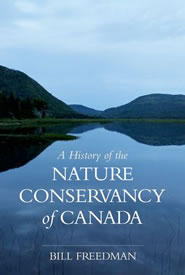A History of the Nature Conservancy of Canada

A History of the Nature Conservancy of Canada (Courtesy Oxford University Press CDA)
The late Professor Bill Freedman’s account of the Nature Conservancy of Canada’s (NCC’s) half century of conservation work, published by Oxford University Press Canada, is the first comprehensive look at the 50-year history of the nation’s largest non-profit land conservation organization.
Bill Freedman was a long-standing NCC volunteer and former National Board Chair. Before his passing in September 2015, Dr. Bill (as he was affectionately known at NCC) authored more than 100 refereed scientific papers and publications. He received a Career Achievement Award from the Canadian Council of University Chairs (2007) and a Canadian Environment Award, Gold Medal Level, in the category of Community Awards for Conservation from the Canadian Geographic Society (2006).
When the book was first released, we spoke with Dr. Bill about the book, the research process and some of the key findings it offers.
NCC: Why did you write this book?
Dr. B: Some of the longer-standing directors and staff of NCC had long been talking about the need for someone to write a history of the organization. In fact, one of the most senior directors started to do a history, but found the task to be bigger than anticipated and did not move forward with it. When I realized that no one was writing a history, and with NCC’s 50th birthday coming up, I decided to take the project on.
I approached senior NCC staff with the offer, and they took me up on it and shipped me four bankers boxes full of minutes and miscellaneous documents, which were later supplemented by many electronic files of more recent events and projects.
On a more personal level, I thought that this was an opportunity for me to be useful to NCC in a way that respected my personal skills and academic and professional background.
NCC: What key insights will readers learn about NCC and conservation in Canada?
Dr. B: The key message is that much that is necessary and useful [in land conservation] can be accomplished by people with a shared vision, organizational and fundraising and science skills, and a passion to conserve biodiversity.
Another key message, however, is that much more still needs to be done — there are many vital privately owned properties that should be conserved by land trusts, and of course the need for stewardship of protected areas runs forever.
NCC: Fifty years is a long time span to survey. What was the research process like?
Dr. B: It was long and slogging, but not so difficult compared with some other writing projects I have done. I received a lot of help from many people who provided me with information about projects they had been involved in, and who criticized draft manuscripts for me.
Even though I wrote the entire book, in the sense of preparing the manuscript, it was definitely a wide-ranging group effort amongst friends and colleagues. Also, the publisher, Oxford University Press Canada, was extremely professional and efficient, and also remarkably tolerant of some late changes to the galleys that were needed to accommodate breaking confidentiality issues. I did this project as a volunteer, and will receive no royalties from sales of the book.
NCC: Who should read this book?
Dr. B: Anyone interested in protected areas and direct action to conserve the biodiversity of Canada would find much or all of the book to be interesting. Of course, anyone specifically interested in NCC would enjoy the story of the organization and its 50-year history.
Find out more about A History of the Nature Conservancy of Canada >



